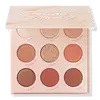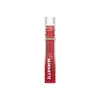What's inside
What's inside
 Key Ingredients
Key Ingredients

 Benefits
Benefits

 Concerns
Concerns

 Ingredients Side-by-side
Ingredients Side-by-side

Zinc Stearate
Cosmetic ColorantSynthetic Fluorphlogopite
Polymethylsilsesquioxane
Magnesium Stearate
Cosmetic ColorantBoron Nitride
AbsorbentDimethicone
EmollientCaprylic/Capric Triglyceride
MaskingPhenoxyethanol
PreservativeCaprylyl Glycol
EmollientEthylhexylglycerin
Skin ConditioningHexylene Glycol
EmulsifyingDimethiconol
EmollientIron Oxides
Mica
Cosmetic ColorantCI 77891
Cosmetic ColorantEthylhexyl Isononanoate
EmollientTrimethylsiloxysilicate
EmollientAlumina
AbrasiveDimethicone Crosspolymer
Emulsion StabilisingIsopropyl Myristate
EmollientCetyl Dimethicone
EmollientStearalkonium Hectorite
Gel FormingTin Oxide
AbrasivePropylene Carbonate
SolventCI 75470
Cosmetic ColorantCI 77491
Cosmetic ColorantTalc
AbrasiveLauroyl Lysine
Skin ConditioningSilica
AbrasiveCI 16035
Cosmetic ColorantCI 19140
Cosmetic ColorantCalcium Sodium Borosilicate
Magnesium Myristate
Aluminum Starch Octenylsuccinate
AbsorbentCI 42090
Cosmetic ColorantZinc Stearate, Synthetic Fluorphlogopite, Polymethylsilsesquioxane, Magnesium Stearate, Boron Nitride, Dimethicone, Caprylic/Capric Triglyceride, Phenoxyethanol, Caprylyl Glycol, Ethylhexylglycerin, Hexylene Glycol, Dimethiconol, Iron Oxides, Mica, CI 77891, Ethylhexyl Isononanoate, Trimethylsiloxysilicate, Alumina, Dimethicone Crosspolymer, Isopropyl Myristate, Cetyl Dimethicone, Stearalkonium Hectorite, Tin Oxide, Propylene Carbonate, CI 75470, CI 77491, Talc, Lauroyl Lysine, Silica, CI 16035, CI 19140, Calcium Sodium Borosilicate, Magnesium Myristate, Aluminum Starch Octenylsuccinate, CI 42090
Dimethicone
EmollientDimethicone Crosspolymer
Emulsion StabilisingPolyglyceryl-2 Triisostearate
EmulsifyingDimethicone/Vinyl Dimethicone Crosspolymer
Skin ConditioningTribehenin
EmollientIsononyl Isononanoate
EmollientTitanium Dioxide
Cosmetic ColorantGlyceryl Caprylate
EmollientCaprylyl Glycol
EmollientSilica
AbrasiveButylene Glycol
HumectantTocopherol
AntioxidantParfum
MaskingCI 19140
Cosmetic ColorantCI 77491
Cosmetic ColorantPigment Red 57
Cosmetic ColorantCI 45410
Cosmetic ColorantCI 15985
Cosmetic ColorantDimethicone, Dimethicone Crosspolymer, Polyglyceryl-2 Triisostearate, Dimethicone/Vinyl Dimethicone Crosspolymer, Tribehenin, Isononyl Isononanoate, Titanium Dioxide, Glyceryl Caprylate, Caprylyl Glycol, Silica, Butylene Glycol, Tocopherol, Parfum, CI 19140, CI 77491, Pigment Red 57, CI 45410, CI 15985
Ingredients Explained
These ingredients are found in both products.
Ingredients higher up in an ingredient list are typically present in a larger amount.
Caprylyl Glycol is a humectant and emollient, meaning it attracts and preserves moisture.
It is a common ingredient in many products, especially those designed to hydrate skin. The primary benefits are retaining moisture, skin softening, and promoting a healthy skin barrier.
Though Caprylyl Glycol is an alcohol derived from fatty acids, it is not the kind that can dry out skin.
This ingredient is also used as a preservative to extend the life of products. It has slight antimicrobial properties.
Learn more about Caprylyl GlycolCI 19140 is also known as Tartrazine. Tartrazine is a synthetic dye used in cosmetics, foods, and medicine to add a yellow color.
Tartrazine is created from petroleum and is water-soluble.
Some people may experience allergies from this dye, especially asthmatics and those with an aspirin intolerance.
Learn more about CI 19140Ci 77491 is also hydrated iron III oxide. It's sole purpose is to give a red/pink hue to products.
Iron III oxides are classified as inorganic chemicals for coloring.
Synthetically created Ci 77491 is considered safer than those naturally found. This is because the synthetically created version may contain less impurities. Iron oxides are generally non-toxic and non-allergenic.
Learn more about CI 77491Dimethicone is a type of synthetic silicone created from natural materials such as quartz.
What it does:
Dimethicone comes in different viscosities:
Depending on the viscosity, dimethicone has different properties.
Ingredients lists don't always show which type is used, so we recommend reaching out to the brand if you have questions about the viscosity.
This ingredient is unlikely to cause irritation because it does not get absorbed into skin. However, people with silicone allergies should be careful about using this ingredient.
Note: Dimethicone may contribute to pilling. This is because it is not oil or water soluble, so pilling may occur when layered with products. When mixed with heavy oils in a formula, the outcome is also quite greasy.
Learn more about DimethiconeDimethicone Crosspolymer is a silicone created by modifying dimethicone with hydrocarbon side chains. Due to its large size, it does not penetrate skin. It is considered non-occlusive.
Dimethicone Crosspolymer is used to stabilize and thicken products. It also helps give products a silky feel.
Silica, also known as silicon dioxide, is a naturally occurring mineral. It is used as a fine, spherical, and porous powder in cosmetics.
Though it has exfoliant properties, the function of silica varies depending on the product.
The unique structure of silica enhances the spreadability and adds smoothness, making it a great texture enhancer.
It is also used as an active carrier, emulsifier, and mattifier due to its ability to absorb excess oil.
In some products, tiny microneedles called spicules are made from silica or hydrolyzed sponge. When you rub them in, they lightly polish away dead skin layers and enhance the penetration of active ingredients.
Learn more about Silica